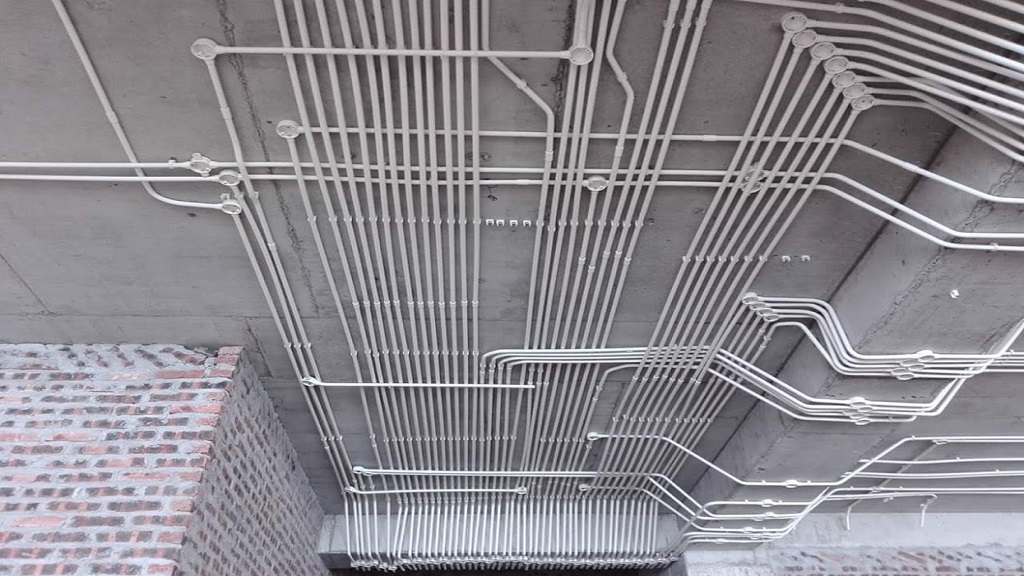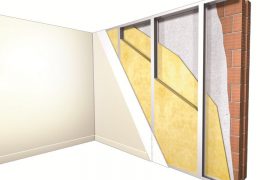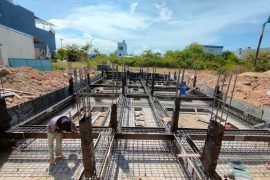Cách đi dây điện âm tường có thể xa lạ với mọi người khi xưa, nhưng nay nó đã trở nên rất phổ biến. Để giúp bạn biết cách đi dây điện âm tường an toàn mà chuẩn xác thì bạn có thể tham khảo những hướng dẫn chi tiết dưới đây của MOIVAONHATOI nhé!
ĐI DÂY ĐIỆN ÂM TƯỜNG LÀ GÌ?
Hiểu đơn giản nhất, điện âm tường là cách thiết kế mạng điện chìm, đi dây bên trong tường hoặc dưới đất. Với kiểu thiết kế này, dây điện sẽ không bị lộ ra ngoài gây nguy hiểm khi sử dụng và quan trọng đó là đảm bảo tính thẩm mỹ cho ngôi nhà của bạn.
CÁCH ĐI DÂY ĐIỆN ÂM TƯỜNG CÓ ƯU VÀ NHƯỢC ĐIỂM GÌ?
Đi dây điện âm tường ngày càng phổ biến trong thiết kế nhà hiện nay. Tuy nhiên với cách đi dây điện kiểu này cũng có những ưu điểm và nhược điểm riêng. Dựa vào những thông tin này sẽ giúp bạn có nên lựa chọn đi dây điện trong tường khi xây nhà không nhé.
ƯU ĐIỂM CỦA CÁCH ĐI DÂY ĐIỆN ÂM TƯỜNG
AN TOÀN VÀ THUẬN TIỆN KHI SỬ DỤNG
Điện là một trong những hạng mục được rất nhiều chủ nhà quan tâm, làm thế nào để an toàn khi sử dụng. Vì vậy khi đi dây điện trong tường sẽ giúp bạn an tâm hơn khi sử dụng, không lo bị điện giật khi gặp sự cố.
Với dây điện bên trong tường bạn sẽ không phải lo lắng khi dây điện bị đứt, bị hở và gây mất an toàn khi sử dụng. Bạn sẽ không còn
ÁP DỤNG CHO NHIỀU CÔNG TRÌNH
Hệ thống dây điện đi ngầm trong tường rất tiện lợi, có thể áp dụng cho nhiều công trình khác nhau từ nhà ở, chung cư cho đến biệt thự, khách sạn, trụ sở công ty… giúp bạn thiết kế không gian dễ dàng hơn mà không mất nhiều thời gian cũng như công sức thực hiện, tránh được các tác động bên ngoài.
CÓ TÍNH THẨM MỸ CAO
Ưu điểm đầu tiên mà bạn dễ dàng nhận thấy khi đi dây điện trong tường đó là tính thẩm mỹ cao. Bước vào ngôi nhà đi dây điện âm tường bạn sẽ thấy sự gọn gàng, ngăn nắp và hiện đại hơn rất nhiều.
Dây điện với những màu sắc khác nhau, chắc chắn sẽ khiến ngôi nhà của bạn trông rất rối mắt. Nếu dây điện lằng nhằng ở bên ngoài, bạn khó có thể sắp xếp cũng như thiết kế nội thất bên trong, làm sao để lựa chọn sơn tường cũng như đồ dùng nội thất phù hợp.
NHƯỢC ĐIỂM CỦA CÁCH ĐI DÂY ĐIỆN ÂM TƯỜNG
Bên cạnh những ưu điểm, đi dây điện bên trong tường cũng có những nhược điểm nhất định mà bạn cần lưu ý.
Chi phí cao hơn
Chi phí ở đây đó là bạn phải thuê thiết kế, mua các phụ kiện để tiến hành đi dây điện bên trong tường của nhà. Bạn cần tìm đến các đơn vị thiết kế, thi công chuyên nghiệp để được tư vấn, thiết kế hệ thống điện một cách hoàn thiện và chi tiết nhất, cùng với đó là các bước thực hiện như thế nào để thuận tiện khi sử dụng.
Vì vậy chi phí thuê thiết kế cũng đáng kể. Cùng với đó bạn phải mua các đồ dùng, phụ kiện cần thiết để phục vụ công việc này. Bạn nên có phương án cụ thể để xác định chi phí để thực hiện nhé.
Gặp khó khăn khi cần sửa chữa
Khó khăn và cũng là nhược điểm thứ hai bạn sẽ gặp phải khi đi dây điện âm tường đó là giải quyết những trục trặc gặp phải trong quá trình sử dụng. Ví dụ một đoạn dây điện nào đó trong tường bị chập, bị đứt bạn sẽ mất nhiều thời gian để sửa vì cần phải đục khoét tường.
Để khắc phục tối đa những nhược điểm này, kiến trúc sư khuyên bạn nên sử dụng các loại dây điện tốt, chất lượng và các phụ kiện đi kèm đảm bảo hạn chế hỏng hóc trong quá trình sử dụng, như vậy sẽ không mất thời gian cũng như chi phí của bạn khi sửa chữa .
NGUYÊN TẮC CẦN NHỚ VỚI CÁCH ĐI DÂY ĐIỆN ÂM TƯỜNG
Theo các kiến trúc sư cũng như những người trong ngành, để việc đi dây điện âm tường chính xác, an toàn và hiệu quả khi sử dụng cũng cần có những nguyên tắc riêng.
Đầu tiên bạn nên tìm hiểu xem các loại dây đi âm tường và âm trong sàn gồm những loại dây điện nào. Thông thường sẽ có các loại dây như sau:
Dây điện các loại
Dây cáp mạng ADSL + mạng nội bộ
Dây điện thoại
Dây cáp tivi
Thứ hai đó là tùy theo số lượng đèn và máy móc cũng như thiết bị bạn cần sử dụng để tính toán số lượng cũng như đưa ra quy cách dây cho phù hợp và an toàn.
Trục dây chính từ đồng hồ đi lên hết các tầng theo kiểu xương sống sẽ có tiết diện cáp từ 6mm → 11mm (tuỳ thuộc vào tổng công suất sử dụng các thiết bị) đến từng tầng có CB ngắt tầng. Từ CB ngắt tầng chia ra các phòng và mỗi phòng lại có CB ngắt phòng riêng.
Quy cách dây nối từ CB tầng cho các CB phòng phải từ cáp 4mm, dây cấp cho bóng đèn là dây 1,5mm , dây cấp cho ổ cắm là 2.5mm. Ngoài ra còn có dây te hay dây mát (dây khử điện rò, chống giật) đi vào từng ổ cắm và nối với cọc đồng chôn trong đất (cọc te) tiết diện dây này từ 1.5mm → 4mm.
Thứ ba đó là đường điện đi bên trong tường nên chia thành nhiều nhánh khác nhau để dễ thao tác, ngắt điện cục bộ từng khi vực, như vậy bạn có thể dễ dàng thay lắp hay sửa chữa khi cần thiết.
Thứ tư đó là nên luồn dây điện trong các ống nhựa, các ống này phải đảm bảo độ cứng, có khả năng chịu lực và thấm nước tốt, như vậy sẽ không dẫn đến tình trạng chập điện hay ảnh hưởng đến chất lượng của dây điện trong quá trình sử dụng. Và bạn nên nhớ mật độ chiếm chỗ của dây so với tiết diện ống dưới 75%.
Thứ năm đó là khi bạn đi dây điện trong tường, bạn nên chọn những nơi khô ráo, tránh xác các nguồn nhiệt lớn hơn 70 độ C để đảm bảo an toàn khi sử dụng.
Thứ sáu là với những không gian như trần la phông, trần thạch cao, tường gạch ống bạn nên chọn ống luồn đàn hồi với hệ thống dẫn điện lắp đặt, như vậy sẽ an toàn hơn.
Thứ bảy , bạn nên dùng màu giống nhau đối với các dây nóng của cùng một đường điện phân phối, khác nhau với hai đường điện phân phối (dây nóng của đường phân phối 1 có màu đỏ, dây nóng đường phân phối 2 có màu vàng).
Thứ tám , không được đặt dây điện trong tường ở những vị trí có thể đóng đinh hay khoan lỗ, như vậy sẽ ảnh hưởng đến toàn bộ hệ thống điện của nhà bạn cũng như gây nguy hiểm khi sử dụng.
Thứ chín đó là không nên đặt dây điện sâu quá 1/3 độ dày của tường, như vậy sẽ tiện lợi hơn khi cần sửa chữa nếu gặp sự cố. Tuy nhiên nếu đặt nông quá sẽ ảnh hưởng đến thẩm mỹ của tường cũng như toàn bộ không gian ngôi nhà của bạn.
Thứ mười , không sử dụng chung đường điện thoại, cáp truyền hình trong thiết kế phòng khách vì đây là hai đường điện riêng, cần thay đổi cũng như sửa chữa thường xuyên, tốt nhất bạn nên để ngoài tường.
CÁCH CHỌN DÂY ĐIỆN ĐỂ ĐI ÂM TƯỜNG AN TOÀN KHI SỬ DỤNG
Để cách đi dây điện âm tường chi tiết và an toàn, điều quan trọng vẫn là cách chọn dây điện để đi. Vậy bạn nên chọn dây như thế nào để sử dụng.
Đầu tiên đó là bạn nên chọn dây không bị gãy, nứt vỏ hay biến màu khi bẻ gập. Nếu không khi đưa vào bên trong tường sẽ gặp khó khăn trong quá trình sử dụng, đồng thời sẽ ảnh hưởng đến độ an toàn của bạn cũng như các thành viên trong gia đình.
Thứ hai bạn nên thử dây điện bằng cách đốt phần vỏ bên ngoài. Nếu dây điện cháy sun lại thì nên sử dụng, không sử dụng những loại dây cháy lan ra. Như vậy trong trường hợp dây điện bị cháy sẽ không ảnh hưởng đến các bộ phận khác.
Thứ ba đó là ruột dây đồng bên trong xoắn chặt chẽ, sáng bóng và không bỏ khi gãy. Như vậy dây mới đảm bảo chất lượng cũng như truyền tải điện tốt trong quá trình sử dụng. Đồng thời bạn nên kiểm tra số lượng dây đồng trong lõi có ghi đúng với số lượng được in bên ngoài vỏ dây điện hay không.
Chọn dây đảm bảo các yếu tố trên sẽ giúp bạn an tâm khi lắp đặt, giảm thiểu rủi ro trong quá trình sử dụng, tiết kiệm chi phí cho gia đình bạn khi thiết kế nhà.
CÁCH ĐI DÂY ĐIỆN ÂM TƯỜNG AN TOÀN VÀ CHUẨN TRONG XÂY DỰNG
Bước 1: Xác định các vị trí đi dây điện trong tường
Bước đầu tiên và cũng là bước cơ bản nhất khi bắt tay vào đi dây điện trong tường đó là có bản thiết kế và xác định được vị trí các thiết bị sử dụng trong nhà. Dựa vào bản thiết kế, bạn sẽ biết được vị trí nào nên đặt ổ cắm, vị trí nào sẽ đi dây điện trong tường. Cách xác định chính xác các thiết bị cần thiết sẽ giúp bạn dễ dàng lắp đặt, sắp xếp lắp đặt vị trí nào trước, cái nào sau đồng thời khắc phục những sự cố không mong muốn.
Bước 2: Lên sơ đồ hệ thống đường đi của dây điện
Đường dây điện đi trong tường sẽ có bản thiết kế chi tiết, vì vậy bạn nên làm theo bản thiết kế để đảm bảo tính chính xác cũng như an toàn khi sử dụng. Bạn cần giữ bản vẽ đi dây điện âm tường này để biết vị trí lắp đặt của các thiết bị để xem xét lại khi xảy ra sự cố mong muốn.
Bước 3: Tiến hành lắp điện âm tường chuẩn và an toàn
Đầu tiên bạn tạo rãnh tường :Dựa trên bản thiết kế toàn bộ hệ thống điện cần thi công, bạn dùng phấn hoặc bút để đánh dấu trên tường để xác định đường đi của dây điện. Đây là khâu rất quan trọng giúp bạn nhìn rõ đường dây điện đi, cách tạo rãnh trên tường để không gây nhầm lẫn cũng như hạn chế ảnh hưởng đến tường của nhà. Tiếp đó bạn dùng máy gạch hoặc máy khoan để cắt theo đường vừa vẽ, độ rộng và độ sâu tùy vào mong muốn của bạn.
Tiếp theo tiến hành đi đường ống : Bạn nên chọn đường ống với kích thước phù hợp, chất lượng đảm bảo để sử dụng. Các loại dây điện âm tường gồm có dây điện các loại, dây cáp điện thoại, tivi, dây cáp mạng và mạng nội bộ… Các ống dây sẽ được đưa vào rãnh và cố định bằng dây kẽm. Đường ống này cần chịu nhiệt tốt, không bị thấm nước để không ảnh hưởng đến dây điện bên trong.
Tiến hành luồn dây điện : Sau khi hoàn thiện đường ống sẽ tiến hành luồn dây điện. Theo các kiến trúc sư có nhiều năm kinh nghiệm, bạn nên luồn dây trước khi thi công sẽ tránh được những khó khăn khi thực hiện.
Cuối cùng là hoàn thành : Đây là giai đoạn cuối cùng khi tiến hành thi công lắp đặt dây điện trong tường. Bạn có thể trám lại những đường ống trước đó để đảm bảo an toàn và tính thẩm mỹ cho tường.
CÁCH KHẮC PHỤC SỰ CỐ KHI ĐI DÂY ĐIỆN ÂM TƯỜNG
ĐƯỜNG DÂY ĐIỆN ÂM TƯỜNG BỊ RÒ RỈ
Nhiều người vẫn nghĩ khi đi dây điện âm tường sẽ tuyệt đối an toàn khi sử dụng. Tuy nhiên vẫn có nhiều trường hợp do tác động bên ngoài sẽ giảm độ bền của dây và gây rò rỉ khi sử dụng. Thông thường sẽ xuất phát từ những nguyên nhân sau:
Có thể do ống gen bao bọc đường dây điện âm tường bị hỏng, thấm nước nên ảnh hưởng đến dây điện bên trong.
Thứ hai đó là do ổ cắm điện đều ở vị trí quá thấp, gần chân tường nên dễ bị ẩm khi gặp mưa lớn hoặc nhà bị ngập. Đó là lý do tại sao khi đặt ổ cắm điện, bạn nên tính toán khoảng cách phù hợp để lắp đặt nhé.
Thứ ba đó là do tường bị thấm và ẩm ướt, nồm ẩm sẽ khiến vỏ bọc đường dây điện đi ngầm, nhất là đường điện đã sử dụng lâu năm không được thay sẽ dẫn đến tình trạng rò rỉ điện.
Khi gặp những tình trạng trên, bạn nên tiến hành khắc phục như sau:
Đầu tiên nên kiểm tra bằng bút thử điện lên chỗ tường có đi dây điện ngầm, nếu bút đỏ ở đâu thì đánh dấu lại và ngắt nguồn điện tại chỗ đó. Bạn dùng máy sấy tóc sấy khô tường, sau đó sử dụng các phương pháp chống ẩm cho tường.
Ở vị trí nào đó của đường dây điện ngầm trong nhà bạn bị cháy, hỏng, ảnh hưởng đến toàn bộ hệ thống điện trong nhà, bạn có thể chọn cách chạy đường dây điện nổi (tuy nhiên tính thẩm mỹ không đẹp vì đường dây điện chạy khắp nhà bạn) hoặc cách 2 là dóc tường ra chạy lại đường dây điện ngầm (cách này thì hơi tốn kém).
Để hạn chế tình trạng này, ngay từ khi đi dây điện âm tường, bạn nên chọn những loại dây có 2 lớp cách điện. Trong cùng là ruột dẫn điện nhiều sợi đồng, lớp giữa chống rò rỉ điện và lớp ngoài có tác dụng cách điện tường với dây điện.
Tiếp theo là đảm bảo lắp đúng quy trình cho đường dây điện đi ngầm, đường dây cần phải được đặt trong ống nhựa bảo vệ, các ống này phải đảm bảo cứng, chịu lực và thấm nước tốt.
Nên lắp đặt riêng cầu dao hoặc thiết bị ngắt/mở điện cho từng tầng hoặc từng vị trí để bảo vệ các thiết bị điện và khi cần phải thay, lắp hay sửa chữa sẽ dễ thao tác ngắt điện cục bộ từng khu vực. Lắp đặt thêm cầu dao chống rò (ELCB) sau cầu dao tự động (MCB) trong hệ thống điện. Loại này vừa bảo vệ ngắn mạch, vừa bảo vệ quá tải, vừa ngắt điện khi phát hiện dòng rò.
HIỆN TƯỢNG CHẬP CHÁY ĐIỆN TRONG TƯỜNG
Với trường hợp chập cháy dây điện thông thường sẽ do các nguyên nhân sau:
Đầu tiên đó là do dùng điện quá tải. Đây là hiện tượng dòng điện của các phụ tải tiêu thụ lớn quá so với dòng điện định mức của dây dẫn, các thiết bị đóng cắt hoặc nguồn cấp.
Nguyên nhân thứ hai là do chập mạch. Các pha chập vào nhau, hoặc dây pha chạm đất làm điện trở dây dẫn giảm, cường độ dòng điện tăng lớn đột ngột dẫn tới cháy cách điện dây dẫn, phát sinh tia lửa điện gây cháy thiết bị điện.
Thứ ba là do đầu nối dây dẫn không tốt làm điện trở dây dẫn tăng lên làm cho điểm nối nóng đỏ gây cháy dây dẫn và các vật cháy liền kề. Khi mối nối lỏng, hở sẽ có hiện tượng tia lửa điện, được phóng qua không khí (móc nối dây dẫn, đóng mở cầu dao, công tắc điện).
Để khắc phục tình trạng chập cháy điện trong tường này, đầu tiên bạn nên sử dụng máy dò điện âm tường được thiết kế chuyên dụng để phát hiện và kiểm tra vị trí nào đang bị chập cháy.
Sau khi xác định được vị trí, bạn ngắt hết nguồn điện để tiến hành sửa chữa. Nếu chỉ đơn giản là chập cháy ổ cắm thì có thể thay ổ mới. Nhưng nếu đó là chập cháy dây điện bên trong tường, bạn phải tiến hành đục tường để đấu nối dây hoặc thay dây khi cần.
Khi xảy ra chập cháy điện do các mối nối lỏng vậy nên các mối nối phải đấu cẩn thận và có băng dính bằng cách bọc băng dính điện bên ngoài, không nên kéo căng và để các vật nặng lên đường dây.
Tốt nhất bạn nên giảm thiểu việc sử dụng các thiết bị điện không cần thiết. Sử dụng cầu dao điện, aptomat tự động ngắt điện khi có điện chập xảy ra để phòng ngừa tối đa việc chập cháy hệ thống điện.
Hi vọng với các bước hướng dẫn cách đi dây điện âm tường trên đây cũng như cách khắc phục các sự cố thường gặp sẽ giúp bạn có thêm kinh nghiệm trong lĩnh vực này, đảm bảo an toàn cũng như giảm thiểu chi phí sửa chữa cho ngôi nhà khi cần thiết.



